Water and Energy Efficiency Grant Fact Sheet
 This application is currently open for FY24 and FY25. The first application period closed on February 22, 2024. The second application period closes on October 30, 2024. Click the fact sheet below to learn more about eligible applicants and projects, federal funding amounts, and how WaterNow can support your application process.
This application is currently open for FY24 and FY25. The first application period closed on February 22, 2024. The second application period closes on October 30, 2024. Click the fact sheet below to learn more about eligible applicants and projects, federal funding amounts, and how WaterNow can support your application process.
Water Affordability Dashboard
Water Affordability Dashboard
 The Water Affordability Dashboard is a tool developed by the Nicholas Institute's Water Policy Program to provide a clearer picture of how affordable water services are in the United States. The dashboard helps users answer four questions for each utility:
The Water Affordability Dashboard is a tool developed by the Nicholas Institute's Water Policy Program to provide a clearer picture of how affordable water services are in the United States. The dashboard helps users answer four questions for each utility:
- Who lives in the utility's service boundaries?
- How much do water services cost?
- How affordable are water services?
- How does affordability change with water usage?
The data and code behind the dashboard are open source to enable others to use the data to ask their own questions, explore solutions, and work toward improved water affordability and equity.
The dashboard was designed to allow users to explore the affordability of water services (drinking water, wastewater, and stormwater) within their utility and across other utilities. You can learn more about the community served by a utility, the cost of water services, and the affordability of those services for a community.
Click the link below to access the dashboard.
FAQ Scaling Investment in Localized Water Strategies
 Scaling Up Public Investment In Localized Water Strategies
Scaling Up Public Investment In Localized Water Strategies
How Can Utilities Capitalize Spending On Consumer Rebates? Frequently Asked Questions
Green roofs, permeable pavements, water- efficient appliances and landscaping are all examples of “localized” water infrastructure distributed across homes, businesses, and public spaces. These strategies work in concert with and supplement conventional water systems but are often more affordable and flexible than centralized alternatives. At scale, they are highly effective and perform the same functions as centralized approaches – expanding supply, safeguarding water quality, protecting ecosystems, and managing urban runoff. For many water agencies, the challenge to scaling up localized infrastructure projects is how to pay for them. Consumer incentives for onsite and distributed water solutions, while providing real benefits to utilities, do not produce traditional assets for accounting purposes. So public utilities generally fund these programs out of annual operating cash, rather than bond proceeds. This limits the scale and impact of these strategies. But these programs provide lasting, multi-year benefits and so are not properly accounted for as annual expenses either. This FAQ addresses some of the questions public utilities face when considering whether and how to shift to municipal bond revenue, or other forms of public debt, to finance localized, distributed strategies.
As detailed in WaterNow’s TiR Toolkit (tapin.waternow.org/toolkit), in most cases, the answers to the questions outlined below demonstrate that what may seem like barriers to increased investments in distributed infrastructure can, indeed, be readily addressed.
Equitable Infrastructure Toolkit
 Equitable Infrastructure Toolkit
Equitable Infrastructure Toolkit
River Network's Equitable Infrastructure Toolkit is a one-stop shop for community stakeholders, advocates, and leaders to: (1) Identify the factors that affect water affordability; (2) Become familiar with water infrastructure funding and financing mechanisms; and (3) Understand the role and impact of local, state, and federal entities and community organizations in addressing affordability and sustainability.
The toolkit includes sections on affordability, decision-making, and an overview of how utilities operate and how those decisions impact water affordability. It also includes a glossary and a downloadable version for offline use.
Click the link below to explore the toolkit.
Non-Potable Water Reuse Calculator
Non-Potable Environmental and Economic Water Reuse (NEWR) Calculator
The Non-Potable Environmental and Economic Water Reuse (NEWR) Calculator is a simple to use web-based tool for screening-level assessments of source water options for any urban building location across the United States that is considering onsite non-potable reuse.
Non-potable water reuse is one solution that can help communities reclaim, recycle, and then reuse water for non-drinking water purposes, such as toilet flushing, clothes washing, and irrigation. NEWR can be used to identify the most environmentally and cost-effective suite of source water options to meet non-potable needs based on geography, climate, building size, and building type. Potential environmental impacts are estimated in NEWR using life cycle assessment following guidelines specified by the International Organization for Standardization (ISO 14040/44).
Access the calculator through the link below.
Navigate the Flood
The Navigate the Flood guide streamlines local decision-maker’s and city and utility staff’s navigation of the vast and complex array of technical guidance and funding resources for stormwater and flood planning and management. For local elected and appointed officials, the Guide offers a way to orient themselves to the fundamentals and language of stormwater and flood management via an overview of the key decision-making steps towards planning for and building sustainable, resilient, and equitable stormwater and flood management systems. For managers and staff, the Guide offers a way to drill down into these key planning and implementing steps and easily access a deep well of existing technical and financial resources that are available to support stormwater and flood planning and management.
For managers and staff, the Guide offers a way to drill down into these key planning and implementing steps and easily access a deep well of existing technical and financial resources that are available to support stormwater and flood planning and management.
The five steps to Navigate the Flood are:
- Define the Condition of Your Community’s System
- Identify Your Community’s Challenges
- Set Your Community’s Visions and Goals
- Choose Your Community’s Solutions
- Put Your Community’s Plan into Action
Click the link below to access to access the guide and navigate your way through each step or download the Navigator’s Checklist, a way for local leaders and managers to wade into each of these five steps by outlining key questions to consider and pose to technical staff along the way.
This Guide is a joint initiative between the Water Center at the University of Pennsylvania and WaterNow Alliance.
Enhanced Model Stormwater Ordinance
Enhanced Model Stormwater Ordinance for Municipalities
New Jersey Future has put together an Enhanced Model Stormwater Ordinance as a key tool to implementing public and private green infrastructure, a group of practices that mimic the natural water cycle to capture rainwater where it falls. Municipal stormwater ordinances establish requirements for how development projects will manage stormwater. Municipalities in New Jersey already use stormwater ordinances (also called stormwater control ordinances) to control runoff, improve water quality, and maintain groundwater levels. The New Jersey Department of Environmental Protection (NJDEP) requires every municipality to adopt a stormwater ordinance and update it as the state’s Stormwater Management Rules are amended.
With the state’s most recent amendments (effective March 2) now requiring stormwater to be managed with green infrastructure (GI), each municipality can decide how best to bring the benefits of GI to their communities with an enhanced ordinance that is stronger than the state’s minimum requirements. To help municipalities make choices about how to adopt a stronger stormwater ordinance, New Jersey Future developed a new tool, the Enhanced Model Stormwater Ordinance for Municipalities. It compares and recommends several options for improvements to the minimum requirements in NJDEP’s example stormwater ordinance. While NJDEP’s requirements represent a paradigm shift in stormwater management, municipalities that want to get ahead of flooding and climate change, improve water quality in local waterways, and encourage developers to use more GI in their projects should consider going further. Municipalities can use their stormwater ordinance to partner with developers of both public and private projects to build GI, multiplying its benefits.
Click the link below to access the Enhanced Model Stormwater Ordinance.
L2L Operations & Maintenance Manual
On September 10, the City Council of Golden, Colorado, approved a “Laundry-to-Landscape” (L2L) graywater ordinance – the first in Colorado to focus exclusively on L2L systems, and only the fourth graywater ordinance in the state. Golden’s ordinance allows participating single-family residences to water non-edible outdoor plants with water from their laundry machines and  laundry room sinks, meaning the potable water they would have used for irrigation can be saved. The ordinance is a step toward achieving Golden’s sustainability goal of reducing
laundry room sinks, meaning the potable water they would have used for irrigation can be saved. The ordinance is a step toward achieving Golden’s sustainability goal of reducing per capita total water use by at least 15% by 2030.
per capita total water use by at least 15% by 2030.
To provide residents that install L2L systems at their homes, the City developed the Laundry-to-Landscape Operations & Maintenance Manual. The manual provides guidance on how homeowners should operate and maintain their L2L systems to ensure they meet all the public safety and other requirements of Golden's ordinance.
Click the link below to download a copy of the manual from the City's website.
Graywater System Design Criteria Manual
On September 10, the City Council of Golden, Colorado, approved a “Laundry-to-Landscape” (L2L) graywater ordinance – the first in Colorado to focus exclusively on L2L systems, and only the fourth graywater ordinance in the state. Golden’s ordinance allows participating single-family residences to water non-edible outdoor plants with water from their laundry machines and  laundry room sinks, meaning the potable water they would have used for irrigation can be saved. The ordinance is a step toward achieving Golden’s sustainability goal of reducing
laundry room sinks, meaning the potable water they would have used for irrigation can be saved. The ordinance is a step toward achieving Golden’s sustainability goal of reducing per capita total water use by at least 15% by 2030.
per capita total water use by at least 15% by 2030.
To implement its graywater ordinance the City developed a Graywater System Design Criteria Manual. The manual establishes uniform design criteria to ensure L2L systems installed by Golden's residents meet the ordinance requirements.
Click the link below to download a copy of the manual from the City's website.
Lead Communications Toolkit
 Lead Communications Toolkit
Lead Communications Toolkit
"Frequent and transparent communication is key to keeping our communities safe from lead in pipes and plumbing." This American Water Works Association toolkit provides water utilities with customizable, off-the-shelf communications materials they can use to reach their customers, tell the whole story, engage partners, and help schools.
To access the toolkit click the link below.

